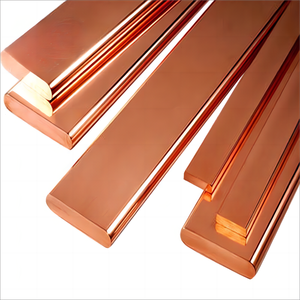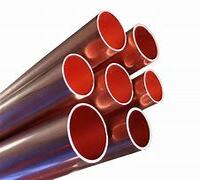1. Introduction
In the past 48 hours, global copper prices have surged due to supply chain disruptions in Chile—the world’s largest copper producer—sparking renewed interest in copper-based materials like the versatile copper rod. With industries scrambling to secure raw materials, understanding what a copper rod is and where it’s used has never been more relevant.

Whether you’re an electrician installing an earthing system, a welder joining metal parts, or a recycler stripping copper wire for scrap, chances are you’ve encountered some form of copper rod—or its close cousins like copper strip, copper bar, or copper pipe.
2. What Is a Copper Rod?
A copper rod is a solid cylindrical bar made primarily of high-conductivity copper. It’s typically produced through hot or cold rolling and comes in various diameters and lengths. Known for its excellent electrical and thermal conductivity, corrosion resistance, and malleability, the copper rod serves as a foundational material in countless industrial applications.
Commonly referred to as rod copper or copper round bar (or round bar copper), these terms describe the same basic product—just with different naming conventions based on region or industry.
3. Types and Applications of Copper Rod
3.1. Electrical and Earthing Uses
One of the most critical uses of copper rod is in grounding and earthing systems. Products like copper earth rod, earthing rod copper, and ground rod copper ensure safe dissipation of electrical faults into the earth.
For cost-effective solutions, many opt for copper bonded earthing rod or copper clad ground rod. These consist of a steel core coated with a layer of pure copper—offering strength from the steel and conductivity from the copper cladding. You’ll also see terms like copper bonded steel, copper clad steel ground rod, and copper clad earth rod used interchangeably in this category.
When shopping, you might compare earthing rod price versus copper rod price—bonded or clad options are often cheaper than solid copper but still meet safety standards.
3.2. Welding and Brazing Applications
Copper rods aren’t just for grounding—they’re also essential in metal joining. A copper brazing rod is used in high-temperature brazing processes, especially when working with copper-to-copper joints.

Professionals often search for copper to copper brazing rods or copper to copper welding rod when repairing HVAC systems or plumbing. Similarly, copper welding rod, copper rod for welding, and welding rod copper all refer to filler materials designed specifically for joining copper components without compromising conductivity.
Copper rod welding requires skill and the right flux, but it delivers strong, reliable joints—critical in refrigeration and air conditioning systems.
4. Copper Rod vs. Related Copper Products
4.1. Copper Strip and Flat Forms
While copper rod is round, copper strip offers a flat profile—ideal for busbars, grounding straps, or decorative edging. You’ll find terms like flat copper strip, thin copper strips, beryllium copper strip, and nickel plated copper strip depending on the alloy and finish.
Common queries include ‘copper strip near me,’ ‘copper strip price,’ or ‘where to buy copper strips.’ Sizes like 1mm copper strip or copper earth strip 25x3mm price are frequently searched by engineers and DIYers alike.
Recyclers often look up ‘best way to strip copper wire,’ ‘fast way to strip copper wire,’ or even ‘burning copper wire for scrap’—though the latter is unsafe and discouraged. Proper methods include mechanical strippers for ‘stripping copper wire for scrap’ or ‘stripping wire for recycling.’
Specialty items like copper tape for snails (used in gardening) or copper roof strip show how diverse copper’s applications are.
4.2. Copper Bar and Busbar Variants
Copper bar—also called copper flat bar or flexible copper bar—is used in power distribution. The copper bus bar carries high currents in switchgear and substations. Flexible copper bus bar versions accommodate movement in dynamic systems.

Other forms include copper ingot (raw material for casting rods or bars) and cu bars for industrial resale. Prices like 1oz copper price or copper ingot price fluctuate daily with the LME (London Metal Exchange).
4.3. Copper Pipe and Tubing
Though not rods, copper pipes are closely related. Terms like copper pipework, copper tubing, and aircon copper pipe dominate HVAC discussions. Popular sizes include 15mm copper pipe, 22mm copper tube, and 3/4 copper tubing.
Professionals often ask about ac copper pipe price, bending copper pipe, or copper pipe soldering techniques. Fittings like copper pipe connectors and copper tubing fittings complete these systems.
Note: PEX plumbing pipes are increasingly replacing copper in residential water lines—but copper remains preferred for AC refrigerant lines due to its durability and leak resistance.
5. Pricing and Market Trends
Copper rod price varies by purity, diameter, and market conditions. As of this week, prices are climbing due to mining delays in South America. Similarly, copper strip price and copper pipe price are trending upward.
For budget-conscious buyers, copper bonded or copper clad alternatives offer savings without sacrificing too much performance—especially in non-critical earthing applications.
When sourcing materials, always verify specifications: a ‘copper clad steel earth rod’ isn’t the same as a solid ‘copper earth rod’ in high-corrosion environments.
6. Conclusion
From ensuring electrical safety with an earthing rod copper to enabling precision joins with a copper to copper welding rod, the humble copper rod is a silent workhorse across industries. Paired with related products like copper strip, copper bar, and copper pipe, it forms the backbone of modern electrical and thermal infrastructure.
Whether you’re comparing earthing rod price, learning the best way to strip copper wire, or selecting the right aircon copper tube, understanding copper’s many forms helps you make smarter, safer, and more cost-effective decisions.
Our Website founded on October 17, 2012, is a high-tech enterprise committed to the research and development, production, processing, sales and technical services of ceramic relative materials such as What. Our products includes but not limited to Boron Carbide Ceramic Products, Boron Nitride Ceramic Products, Silicon Carbide Ceramic Products, Silicon Nitride Ceramic Products, Zirconium Dioxide Ceramic Products, etc. If you are interested, please feel free to contact us.

